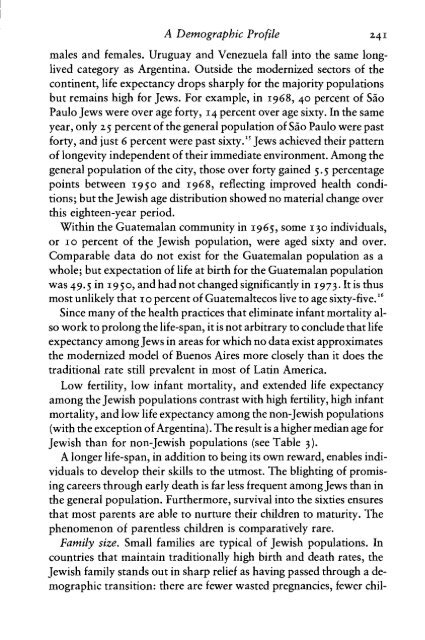Introduction - American Jewish Archives
Introduction - American Jewish Archives
Introduction - American Jewish Archives
Create successful ePaper yourself
Turn your PDF publications into a flip-book with our unique Google optimized e-Paper software.
A Demographic Profile 241<br />
males and females. Uruguay and Venezuela fall into the same longlived<br />
category as Argentina. Outside the modernized sectors of the<br />
continent, life expectancy drops sharply for the majority populations<br />
but remains high for Jews. For example, in 1968, 40 percent of Sio<br />
Paulo Jews were over age forty, 14 percent over age sixty. In the same<br />
year, only 25 percent of the general population of Sio Paulo were past<br />
forty, and just 6 percent were past sixty." Jews achieved their pattern<br />
of longevity independent of their immediate environment. Among the<br />
general population of the city, those over forty gained 5.5 percentage<br />
points between 19 50 and 1968, reflecting improved health conditions;<br />
but the <strong>Jewish</strong> age distribution showed no material change over<br />
this eighteen-year period.<br />
Within the Guatemalan community in 1965, some 130 individuals,<br />
or 10 percent of the <strong>Jewish</strong> population, were aged sixty and over.<br />
Comparable data do not exist for the Guatemalan population as a<br />
whole; but expectation of life at birth for the Guatemalan population<br />
was 49.5 in 1950, and had not changed significantly in 1973. It is thus<br />
most unlikely that 10 percent of Guatemaltecos live to age sixty-five.16<br />
Since many of the health practices that eliminate infant mortality also<br />
work to prolong the life-span, it is not arbitrary to conclude that life<br />
expectancy among Jews in areas for which no data exist approximates<br />
the modernized model of Buenos Aires more closely than it does the<br />
traditional rate still prevalent in most of Latin America.<br />
Low fertility, low infant mortality, and extended life expectancy<br />
among the <strong>Jewish</strong> populations contrast with high fertility, high infant<br />
mortality, and low life expectancy among the non-<strong>Jewish</strong> populations<br />
(with the exception of Argentina). The result is a higher median age for<br />
<strong>Jewish</strong> than for non-<strong>Jewish</strong> populations (see Table 3).<br />
A longer life-span, in addition to being its own reward, enables individuals<br />
to develop their skills to the utmost. The blighting of promising<br />
careers through early death is far less frequent among Jews than in<br />
the general population. Furthermore, survival into the sixties ensures<br />
that most parents are able to nurture their children to maturity. The<br />
phenomenon of parentless children is comparatively rare.<br />
Family size. Small families are typical of <strong>Jewish</strong> populations. In<br />
countries that maintain traditionally high birth and death rates, the<br />
<strong>Jewish</strong> family stands out in sharp relief as having passed through a demographic<br />
transition: there are fewer wasted pregnancies, fewer chil-

















